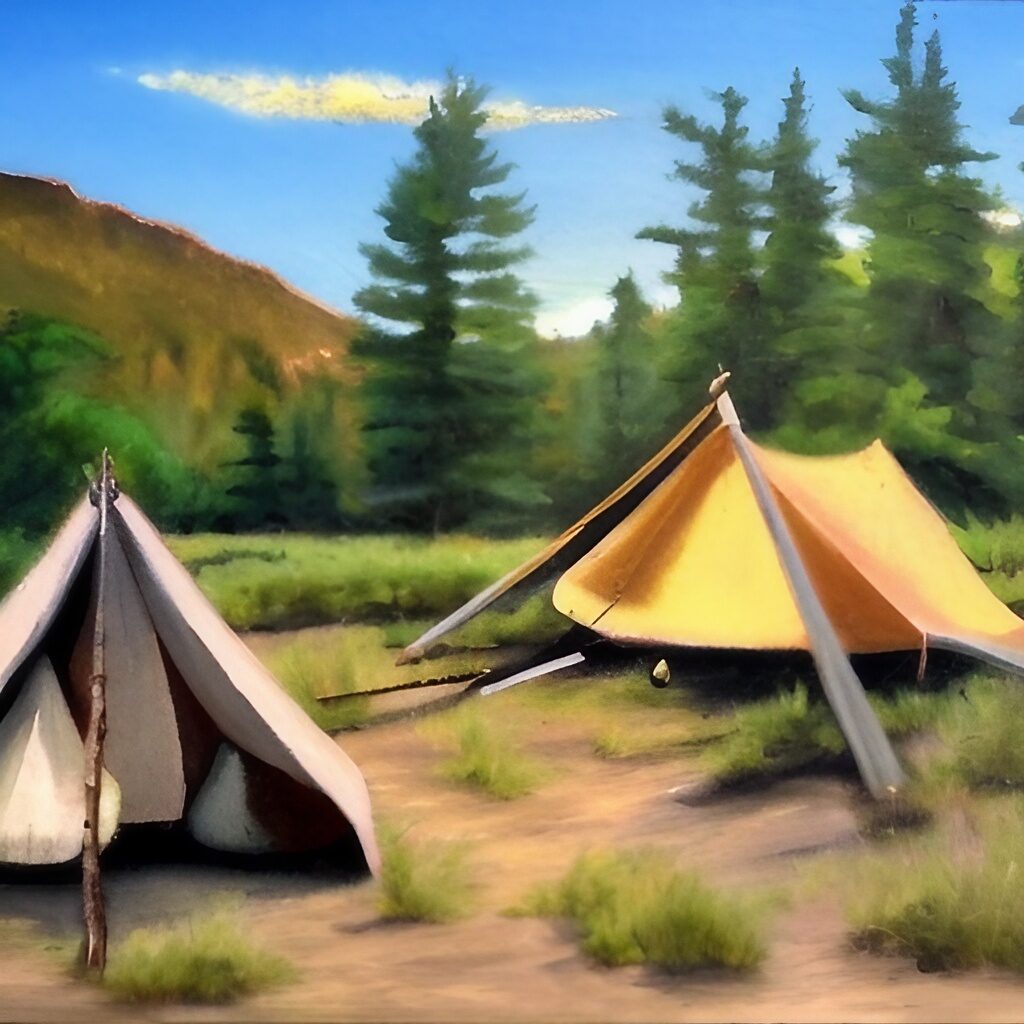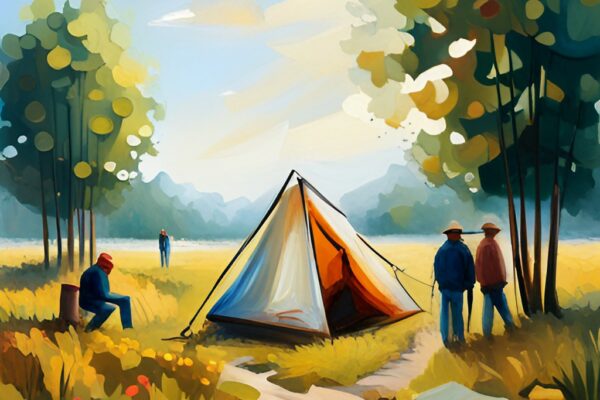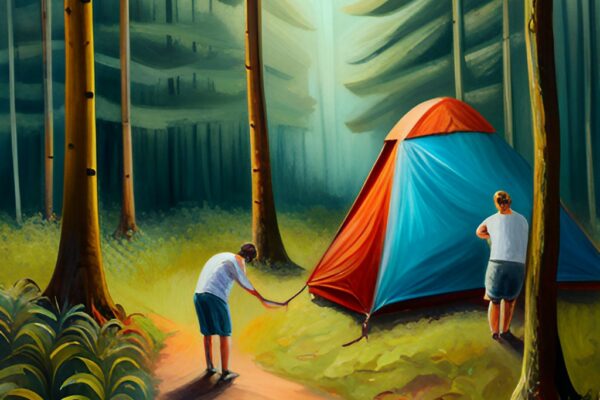
Camping without the support of typical campground amenities (known as backcountry or primitive camping) can sound a little scary.
After all, there’re a lot of things you need to be fully self-sufficient in the backcountry. So we’re here to break all those components down into an easy-to-digest list.
In a nutshell, here are the essentials for a primitive camping trip:
- Backpack
- Clothes
- Shelter
- Sleep System
- Water
- Food
- Food Prep
- First Aid Kit
- The Legal Stuff
- Personal Items
- Fire Starters
- Navigation
- Hiking Supplies
So now let’s unpack (ha-ha) each area of our checklist.
- 1. Backpack – Primitive Camping Checklist
- 2. Clothes – Primitive Camping Checklist
- 3. Shelter – Primitive Camping Checklist
- 4. Sleep System – Primitive Camping Checklist
- 5. Water – Primitive Camping Checklist
- 6. Food – Primitive Camping Checklist
- 7. Food Prep – Primitive Camping Checklist
- 8. First Aid Kit – Primitive Camping Checklist
- 9. The Legal Stuff – Primitive Camping Checklist
- 10. Personal Items – Primitive Camping Checklist
- 11. Fire Starters – Primitive Camping Checklist
- 12. Navigation – Primitive Camping Checklist
- 13. Hiking Supplies – Primitive Camping Checklist
- Optional Items For a Bit More Comfort – Primitive Camping Checklist
- Alternative Options for the Budget-Conscious Camper – Primitive Camping Checklist
- How to Decide What to Bring – Primitive Camping Checklist
- Conclusion – Primitive Camping Checklist
- Frequently Asked Questions – Primitive Camping Checklist
- What Exactly is Primitive Camping? – FAQs
- Is a Permit Required for Primitive Camping? – FAQs
- What Am I Going to Need for Primitive Camping? – FAQs
- How Do I Locate a Suitable Location for Primitive Camping? – FAQs
- What Should I Be Aware of When Going Primitive Camping? – FAQs
- How Do I Get Rid of Trash While Primitive Camping? – FAQs
- Is it Possible to Build a Fire While Primitive Camping? – FAQs
- Is it Safe to Go Primitive Camping on Your Own? – FAQs
1. Backpack – Primitive Camping Checklist
First and foremost, you’ll need a backpack to carry all your gear.
Choose a backpack anywhere in the 30-50 liter range for a weekend or overnight trip.
If you’re going on a slightly longer trip, say around 3-5 nights, a 50-80 liter pack will better accommodate your stuff.
Lastly, if you’re embarking on a serious expedition longer than five nights, go with at least a 70-liter pack.
2. Clothes – Primitive Camping Checklist
The clothes you bring will be influenced by the weather conditions/temperatures as well as your trip length.
It’s up to you how many pairs of shorts, pants, and shirts you bring. A lot of serious, long-distance backpackers only pack 1 of each to save weight. This means they have to wash their clothes often once they get smelly.
So bring 3 pairs of shorts or bring 1 – it’s really up to you and your specific trip.
In general, we’d suggest bringing 2-3 pairs of socks and 2-3 pairs of underwear. If it’s colder, you can also add a long-sleeved shirt and soft shell jacket.
Whatever you choose, remember one rule: no cotton! It doesn’t wick moisture, so when you sweat, you’ll be walking around in a personal sauna…gross.
The reverse is true if it’s cold: your sweat will act as a chilling agent, possibly leading to hypothermia.
There are a bunch of other reasons to ditch cotton – it takes forever to dry, doesn’t insulate, etc. But to spare you all that, trust us: leave it at home.
3. Shelter – Primitive Camping Checklist
A tent is one of the most popular choices for shelter. Among these are several sub-classes, each with its own best uses.
For instance, tents come in a dizzying range of weights and capacities. They can weigh as low as 2 pounds and fit only one person. Or they can be a hefty 9 pounds but accommodate 2 – 4 people.
A camper who wants to embark on an arduous thru-hike would opt for the lightest shelter possible, like that 2 pound tent.
But someone going camping with a friend or two may want to choose a larger tent.
There’s also a bivy bag, which is considered the king of ultralight shelters.
Usually, the most determined of ultralight hikers opt for bivys. Often weighing mere ounces, a bivy is basically a sleeping bag.
Most feature a face dome that can be zipped for weather protection. This basically-zero weight makes them perfect for hardcore treks where miles are crushed and every ounce counts.
Because a bivy is self-contained, there aren’t usually any extra parts to bring, like a fly or poles. Check out our detailed article on bivy vs tent if you want to learn more.
Finally, we have hammocks (see our best hammocks with Mosquito Netting). These are considered the airborne alternative to ground-dwelling tents. Hammocks are lighter than most tents, which makes them an attractive solution.
But they’re best used in wooded areas with lots of trees. If you camp in the desert with a hammock, you’ll be out of luck. To learn more about the pros and cons of these two systems, check out our article on tent vs hammock camping.
Now, unless you opt for a bivy bag, each system has its own set of components that it needs to function.
The first of these components is a tarp or rainfly in case of soggy weather.
You’ll also need stakes to properly anchor your shelter.
And don’t forget to bring an extra stake or two; those things get easily bent out of shape – literally! Hammock campers will need these as well so the rainfly can be staked down.
Finally, don’t forget your ropes/guy lines to actually attach your stakes to your shelter and rainfly.
4. Sleep System – Primitive Camping Checklist
Again, whether or not you’re a hammock lover or tent camper, you’ll need a sleeping bag. Be sure yours is at least a 3 season bag that’s lightweight and packable.
You’ll need to pair the sleeping bag with a sleeping pad. The ground is cold and hard, and I guarantee you’ll feel every inch of it if you try to skip this step.
Pads shield you from this by providing both cushioning and insulation.
Also remember your camp pillow – sleeping bags don’t come with those, after all. Don’t worry, they aren’t a huge inconvenience. In fact, most are so light and tiny they pack down to the size of a coffee mug.
If you’re a cold sleeper or just want that extra luxury, feel free to bring an extra blanket. Just know that you’re adding extra weight to your load.
5. Water – Primitive Camping Checklist
If you’re going on an overnight stay, you can bring the water that you need.
But if your trip is longer than one day, chances are you’ll have to acquire water on your travels. For that, you’ll need to bring some sort of water filtration system.
Why? Because no matter how crystal-clear a stream may look, there are millions of tiny, creepy crawlies swimming through that water.
So to keep from slurping up those creepies, you have water filtration.
There are many options on the market, ranging from plastic bags with filters built in, special straws, or purification tablets.
Whatever you choose, just be sure you know how to use your particular system before you go.
Don’t forget water bottles to store it all in. Alternatively, you can use a hydration pack, which is basically a wearable water bottle.
6. Food – Primitive Camping Checklist
If you’ve done any reading about camping, you’ve probably heard about dehydrated meals.
As weird as they sound, they’re an amazing food option. It’s literally a normal meal, but with the water removed. They provide the protein and nutrients you need, especially when you’re burning a lot of fuel through strenuous hiking.
When you add all of the above (plus they’re incredibly lightweight), it’s no wonder they’re the top choice of long-distance thru-hikers.
Dehydrated meals can get a little expensive, so if your budget doesn’t allow for it, there’s always canned items.
But these will be heavy and are usually “separate” items, like “canned corn, soup, etc.” In other words, they won’t be as nutritionally comprehensive as a dehydrated meal.
Last but not least, don’t forget snacks! Yeah, it sounds unnecessary, but if you’re going on a long and strenuous trip, you’ll absolutely want something to munch on in between meals.
Peanuts, non-melting candies, dried fruit, and granola are perfect choices for quick and on-the-go refueling.
7. Food Prep – Primitive Camping Checklist
Now that you have all this yummy food, you need something to eat it on and with.
This is what your mess kit is for (check out our list of best mess kits). At the minimum, a basic mess kit will include a dish and a utensil for eating. Most, but not all, kits also include a pot and maybe a pan for cooking.
You can also bring a camp stove and fuel canister to power the stove. This is what you use to reheat your food. It’s also ideal for boiling water for tea or a cup of coffee.
Having said all this, and even though we included a stove in the absolute essentials…it’s sort of optional.
This is especially true for shorter trips. Lukewarm food isn’t so bad for a few days, but I’d definitely not advise it for a dedicated, months-long thru-hike.
8. First Aid Kit – Primitive Camping Checklist
A first aid kit might not “feel” important, but you cannot skip this step. While nature can be mind-blowingly gorgeous, it can be equally as unforgiving.
At the absolute minimum, a first aid kit must contain bandages, gauze, alcohol pads, and a sharp pair of tweezers.
And yes, you’ll most likely need to use those tweezers to pull off ticks! As a fun FYI, we answered the dreaded question of how long ticks can stay on clothes.
9. The Legal Stuff – Primitive Camping Checklist
Despite being relegated towards the end of our list of necessities, there’s still a few things here and there that you definitely wouldn’t want to leave behind.
Legal items are definitely something you will want to remember. For instance, as backward as it seems, you might need to obtain and bring camping permits.
Unfortunately, some locations, like Shenandoah National Park, for example, require permits to stay overnight. Otherwise, if you get caught by patrolling rangers, you’ll face some hefty fines.
10. Personal Items – Primitive Camping Checklist
Anyway, now that we have bureaucracy out of the way, we can move on to personal items.
Bug spray and bear spray are both lifesavers…sometimes literally. Meanwhile, a knife and multitool are great to have on hand for those extra little jobs that you forgot about.
On days when the sun beats down, slather on your sunscreen. This is doubly true for those of you with fairer skin!
When the hot sun gives way to chilly nights, an emergency blanket can provide added warmth. Specially designed to trap every bit of heat, they pack small and light, smaller than a camp pillow.
Finally….remember to bring your toilet paper and trowel! Need I say more about this one?
11. Fire Starters – Primitive Camping Checklist
If you enjoy a fire at night, you’ll need some way of building the fire. There’s a whole range of fire-starting products to pick from if you don’t already own one.
Or stay basic with a tried-and-true box of matches or a lighter….sealed in a waterproof bag, of course.
12. Navigation – Primitive Camping Checklist
Pack a map and know how to use it. Even if the trail is marked, maps are treasure troves of information regarding elevation profiles, nearby shelters, and water sources.
Additionally, you can bring a compass, but it’s not as crucial for a well-marked trail. If you need some pointers, read our guide on how to use a compass.
13. Hiking Supplies – Primitive Camping Checklist
For backpackers, bring hiking poles. This is another non-negotiable unless you’re walking on a 100% flat rail trail or you’re biking.
Trust me, I learned this the hard way several years ago. My knees are still messed up from the five days I trekked without poles.
When it gets dark, a headlamp is a useful tool to have. The reason why I marked this as a necessity is that there will inevitably come a day when you miscalculate your distance and end up having to hike in the pitch darkness.
Believe it or not, this exact thing happened to a hiker I met.
He got chased out of his camp by a bear – he was illegally camping in a non-designated site, so this was kind of his fault. The poor guy then had to haul himself to a proper, designated campsite at midnight.
I bet he was glad to have his headlamp.
Optional Items For a Bit More Comfort – Primitive Camping Checklist
Since these aren’t essentials, you don’t need to bring any of these items unless you’d like a touch of extra luxury.
Camp lanterns are fun to bring along for reading in your tent after dark. Gently dangling from above, they offer a bit more “homeyness” than a headlamp. Or pack a bundle of string lights for even more charm.
For those lazy days, a reclining camping chair and table bring back a touch of civilization to your campsite while you sit around.
Additionally, packing books or other forms of entertainment (such as board games or cards) help pass the time when you’re stuck at camp. Extended storms are a particularly good example of this.
A lot of long-distance hikers include a pair of camp sandals in their gear. This way, they can let their sweaty, stinky boots air out while performing tasks around camp in breathable comfort.
Alternative Options for the Budget-Conscious Camper – Primitive Camping Checklist
If all of the above has you clutching your wallet in a panic…well, you wouldn’t really be overreacting. It’s sad but true: there’s no doubt that camping has a lot of costs.
But there are ways to get around this. No one said you had to buy the top-of-the-line, carbon hiking poles. The poles I use (and dearly love!) were a cheap-o set from WalMart that has served me faithfully for years.
Do you really need a special camping pillow? Some hikers are content to bundle their clothes into the stuff sack of their sleeping bag as a makeshift pillow.
As you’ll quickly notice, a lot of these quick hacks boil down to personal comfort. For instance, you may find a pillow made of clothes to be completely unacceptable. Conversely, I might not mind if it saves me a buck or two.
Another perfect example: a tent easily represents one of the largest costs to campers. So you could choose a slightly heavier tent knowing that it will be less fun to carry.
It’s up to you to decide if you can handle the discomfort of a few extra pounds or if your wallet can handle the strain of a premier, ultralight option.
Money savings don’t just occur with big-cost items like tents. You can save cash on the smaller items too.
Consider your first aid kit. Do you need to purchase a brand new, all-inclusive 20-piece kit? Or can you find everyday medical items in your own home, pack them in an Altoids tin, and call it a day?
There’s no wrong answers here. Usually, the worst-case scenario results in going a little too cheap, being slightly uncomfortable, and investing a little more wisely next time.
For instance, the sleeping pad I use is not the best. It was affordable, but after a week of sleeping on it, I think next time I’m going to upgrade to a slightly cushier pad.
Sure, I woke up sore some mornings. But in the end, I think that’s a worthy tradeoff to make. I’d rather go on the trip and be a little uncomfortable instead of not going at all because the gear was too costly.
How to Decide What to Bring – Primitive Camping Checklist
Maybe you’ve read this far, and everything makes sense. Except now you’re even more overwhelmed than when you started.
You may ask, what makes the most sense for me and my trip?
Well, you can start by considering some of the criteria in our prior budget section.
Think about your personal comfort preferences. Are you okay with a few comfort-related sacrifices in order to save on weight?
If you are, then you can immediately scratch off items like a camping chair, table, and a camping lantern. There’s really no need to add the extra bulk.
And best of all, you can save yourself the agonizing back-and-forth process of “should I or shouldn’t i?”
This is a deceptively simple baseline you can apply to almost every aspect of your kit.
Consider the earlier example of lukewarm food. If you’re fine with that, cross the stove off your checklist.
Or if you only own a pair of hiking shorts and 2 wicking shirts (*ahem,* clothes not made of cotton…) well, those will do!
Skip the stress and hassle of trying to buy what will most likely be more than what you need. Sometimes the best gear is what you have on hand.
Conclusion – Primitive Camping Checklist
I applaud your attention to detail and dedication to making it this far!
As you can surely see, there’s plenty of things you need to bring on your primitive camping trip.
Yes, it can be intimidating to ponder being away from civilization and even the minimal (but overlooked!) amenities at a front-country campground.
But I promise you, it’s absolutely worth it. The sense of freedom from shedding all the extra baggage is amazing. Not to mention the confidence boost from your own self-sufficiency!
Hopefully, this article educated you on your endeavor to build your kit. And I personally hope it’s inspired you to get out there and try it!
Frequently Asked Questions – Primitive Camping Checklist
What Exactly is Primitive Camping? – FAQs
Primitive camping, also known as backcountry camping or wilderness camping, entails camping in remote locations with few or no amenities like running water, electricity, or restrooms.
Is a Permit Required for Primitive Camping? – FAQs
Typically yes, many public lands require permits for backcountry camping in order to reduce environmental impact and ensure safety.
What Am I Going to Need for Primitive Camping? – FAQs
A tent or shelter, sleeping bag and pad, cooking stove and utensils, food and water filtration system, and other items are required for primitive camping, depending on the length of stay and location.
How Do I Locate a Suitable Location for Primitive Camping? – FAQs
To find designated campsites, use online resources such as National Park Service websites and Bureau of Land Management maps, or consult with local outdoor shops that can provide more accurate information on ideal locations.
What Should I Be Aware of When Going Primitive Camping? – FAQs
Before setting up camp, be aware of the wildlife in your area. Know how to properly store food and carry bear spray if necessary.
How Do I Get Rid of Trash While Primitive Camping? – FAQs
To reduce your environmental impact, pack out all trash and follow the Leave No Trace principles. Where available, use established restroom facilities; otherwise, dig a cathole at least 200 feet away from water sources with a trowel.
Is it Possible to Build a Fire While Primitive Camping? – FAQs
Check your local regulations before starting a fire, as wildfires can be dangerous, especially during dry seasons. Building fires may be illegal in some areas, so check with local authorities first.
Is it Safe to Go Primitive Camping on Your Own? – FAQs
While it is possible to go on solo backpacking trips safely if proper preparation guidelines are followed, it is generally recommended to bring at least one other person in case of emergencies.














